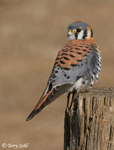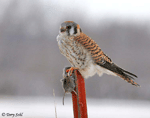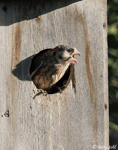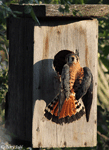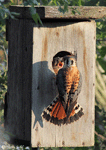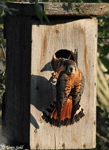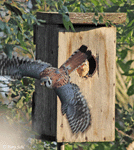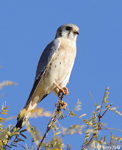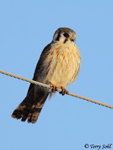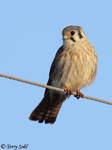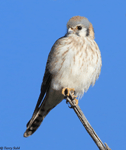| Length: 10 inches | Wingspan: 22 inches | Seasonality: All Seasons / Summer |
| ID Keys: Male rufous back, blue-gray wings, spotted buff breast, 2 dark vertical lines on face. | ||
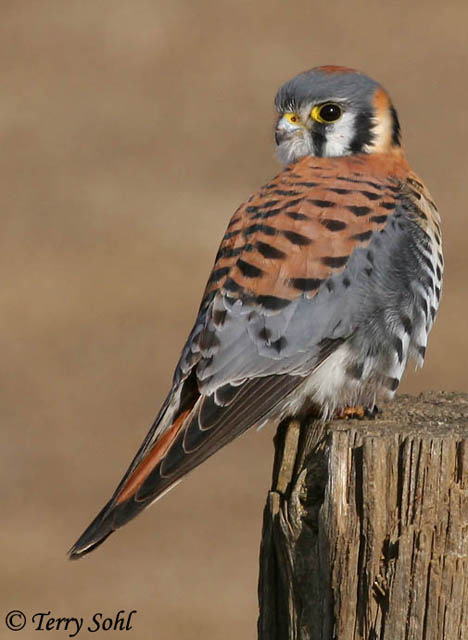 The smallest falcon found in the state, the American Kestrel is often seen perched on telephone wires and
poles, or hovering over fields in search of prey. They can be among the
most abundant raptor in the state at times, especially during migration. American Kestrels will
use nest boxes designed for the species. The photo on the right shows an
adult male. Females are more plainly colored.
The smallest falcon found in the state, the American Kestrel is often seen perched on telephone wires and
poles, or hovering over fields in search of prey. They can be among the
most abundant raptor in the state at times, especially during migration. American Kestrels will
use nest boxes designed for the species. The photo on the right shows an
adult male. Females are more plainly colored.
Habitat: Prefers open country with raised perches and access to nesting cavities.
Diet: Mostly large insects and small rodents, also small birds, reptiles, and amphibians.
Behavior: Primarily hunts by watching from a high perch and swooping down when prey is spotted. Will also hover while searching for prey. During courtship, male and female will often fly together, with the male passing food to the female while in flight.
Nesting: May through July. The nest of an American Kestrel is built in a cavity, often a cavity in a tree, either a natural cavity or an old woodpecker hole. They have also learned to utilize appropriately sized nest boxes. The female usually lays between 4 and 6 eggs. Both parents help to incubate the eggs. When the eggs hatch, the male initially brings food while the female tends to the young, but soon both parents are bringing food back to the nest site. The young fledge after about 4 weeks.
Interactive eBird Map: Click to access an interactive eBird map of American Kestrel sightings
Song: American Kestrel Song, American Kestrel Song (2)
Migration: Semi-permanent resident in the southern two-thirds of the United States. Canada and northern U.S. populations generally move south in the fall, although some may remain in mild winters.
Similar Species: Merlin
Conservation Status: Possibly in decline in parts of the U.S., but overall, populations are not considered to be in serious danger. The IUCN lists the American Kestrel as a species of "Least Concern".
Birdhouses: Will use nestboxes made for Kestrels.
Further Information: 1) USGS Patuxent Bird Identification InfoCenter, American Kestrel
3) Audubon Guide - American Kestrel
Photo Information: February 2nd, 2006 -- Big Sioux Recreation Area -- Terry L. Sohl
Additional Photos: Click on the image chips or text links below for additional, higher-resolution American Kestrel photos.
| Click on the map below for a higher-resolution view |
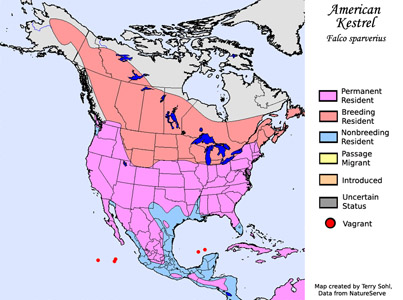 |
| South Dakota Status: Common migrant and uncommon Summer resident throughout the state. Uncommon winter resident, most common in the southern part of the state. |
Click for a higher-resolution version of these photos
